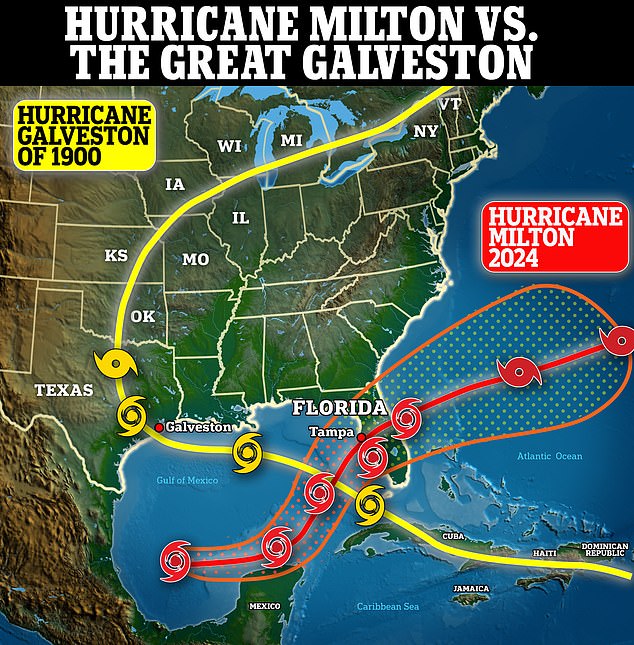Hurricane Milton is on track to become one of the most powerful and destructive storms since 1900.
When the Category 4 hurricane “Greater Galveston” hit, decimated the entire island city of Galveston, Texas, killing 8,000 of the approximately 40,000 residents.
The 15-foot storm surge flooded the island, destroying more than 3,600 buildings, the equivalent of about $26 billion in today’s money.
Forecasters predict Milton, also a Category 4, could bring a record storm surge of 15 feet to Tampa Bay.
While Hurricane Milton has some similarities to the ‘Great Galveston Hurricane’ of 1900, the deadliest in U.S. history, it will not cause the same level of devastation, experts say.
Fortunately, much more sophisticated emergency planning and warning systems exist today, and modern buildings are generally built to withstand tropical storms.
“Hurricane forecasting was in its infancy back in the 1900s, and it took the city of Galveston quite by surprise,” Zierden said.
‘There were very few or no evacuations, and the structures and such were not built to current building codes and were much more vulnerable. So I don’t think we’ll see anything like that again,” he added.
In anticipation of Milton, 51 of Florida’s 67 counties have been placed under emergency storm warnings and evacuations have been ordered for more than 1 million people in West Coast counties.
Both Milton and the Great Galveston Hurricane are Category 4 storms that developed over the Gulf of Mexico and have followed unusual paths from west to east.
This type of trajectory “is relatively rare, but not impossible,” Florida state climatologist David Zierden told DailyMail.com.
“More often, what we see are hurricanes that develop in the northwest Caribbean or even come into the Gulf from the Atlantic, then recur and hit the west coast of Florida, such as Hurricane Charlie in 2004, Hurricane Ian in 2022, Hurricane Wilma that hit southwest Florida in 2005,” he added.
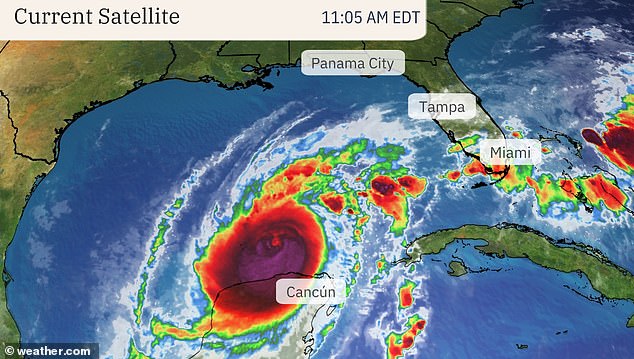
Florida is preparing for Hurricane Milton to make landfall on Wednesday, as it moves toward the coast at 12 miles per hour.
Before the Great Hurricane Galveston struck, the city was on its way to becoming a major American port and thriving commercial center.
But when the storm roared ashore, generating 140 mile per hour winds and 15 feet of storm surge, it caused such extreme devastation that it took Galveston 12 years to rebuild.
After the Great Galveston Hurricane made landfall in Texas, it traveled toward Oklahoma and Kansas, turned northeast, and crossed the Great Lakes and entered Canada.
However, Hurricane Milton immediately began moving east after forming over the Gulf, heading directly toward Florida.
This is even more unusual, but also not unheard of, according to Anthony Yanez, chief meteorologist for local Houston news station KPRC2.
Previous storms have followed this same type of path, such as Hurricane Mitch in 1998 and Hurricane Emily in 2017, he said. wrote.
Hurricane Mitch killed two people and caused $40 million in damage when it made landfall in Florida. There were no fatalities during Hurricane Emily, but damage in Louisiana and Florida cost a total of $10 million.
Hurricane Milton is currently in the Gulf of Mexico, 520 miles southwest of Tampa, where it is expected to hit in full force on Wednesday, and is moving east-northeast.
In terms of damage, displacement and deaths, there is no evidence to suggest that Hurricane Milton will be as devastating as the Great Galveston Hurricane.
But Milton’s impact could still be extreme, especially if the eye of the storm shifts just north of Tampa Bay, historical geographer and hurricane hazard expert Craig Colten told DailyMail.com.
If that happens, “we could have really massive storm surges that would flood the Bay Area and reach Tampa.” “St. Pete could also get a significant amount of water, a more direct increase,” he said.
‘It could be devastating. “This could knock down bridges, disrupt water supply systems and disrupt all types of infrastructure,” he added.
What’s more, Milton’s impact could be compounded by the devastation of Hurricane Helene, which devastated the southeastern United States just 10 days before experts began issuing warnings about the storm.
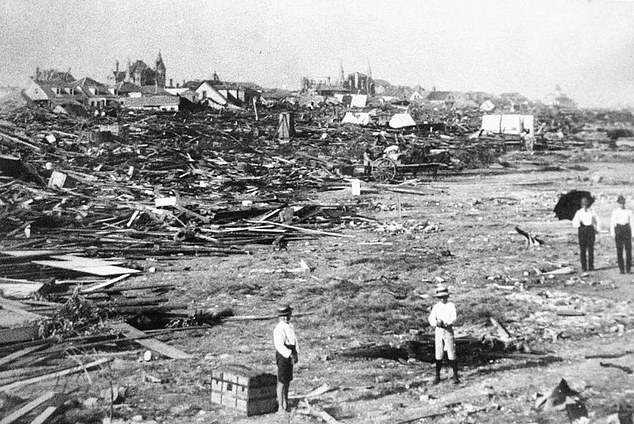
The Great Galveston Hurricane decimated the entire island city of Galveston, Texas, on September 8, 1900.
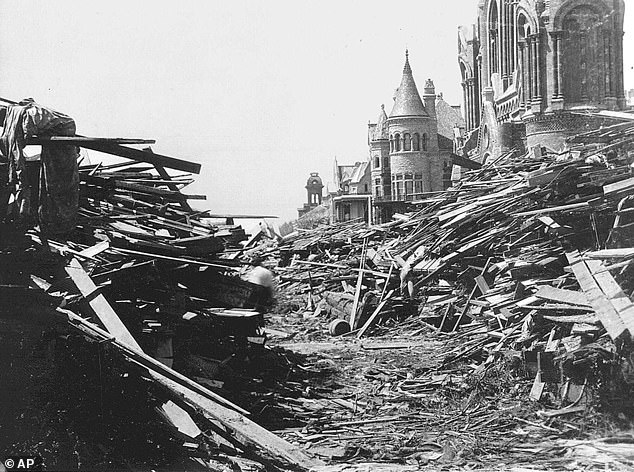
More than 6,000 people died when a storm surge of eight to 15 feet flooded the island, destroying more than half of the homes and buildings.
Helene killed at least 225 people. Hundreds of victims remain missing.
“Unfortunately, some of Helene’s victims are in the path of this storm,” Gov. Ron DeSantis said during a news conference Monday.
“A lot of these homeowners are in recovery mode,” Zierden said.
“They probably didn’t have the time or resources to prepare for this as much as they normally would,” he added.
This could compound the damage from this approaching storm, especially as debris from Helene is carried by Milton’s storm surge, Zierden said.
More than 12,000 cubic yards of debris have been removed in areas of Florida affected by Helene in less than two days, officials said.
But he hopes that with Helene’s memory still fresh, more people will take evacuation orders seriously, which could reduce the total number of injuries and deaths.
Milton rapidly intensified over the Gulf of Mexico on Monday, strengthening from a Category 1 hurricane to a near-record Category 5 hurricane with winds of 180 miles per hour.
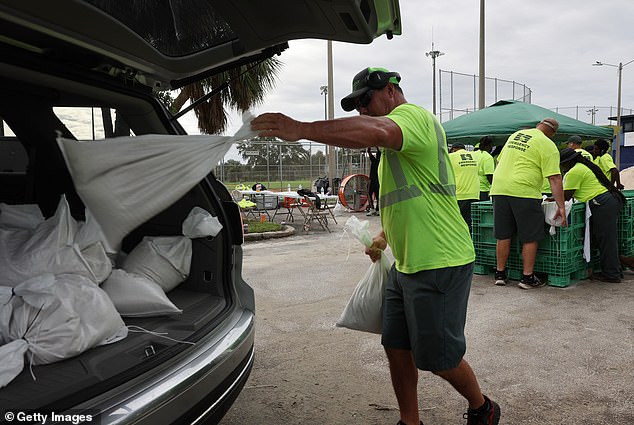
Floridians still in ‘recovery mode’ after Hurricane Helene
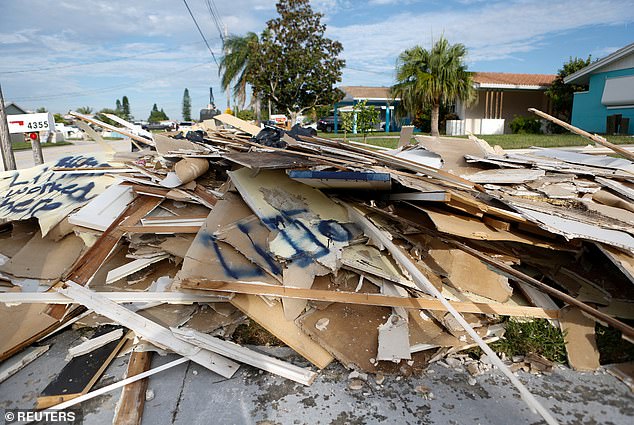
More than 12,000 cubic yards of debris have been removed in areas of Florida affected by Helene in less than two days, officials said.
The storm has since weakened to a Category 4, but is expected to It will remain an “extremely dangerous hurricane” until it makes landfall on Florida’s west coast, according to the NHC.
The NHC also said the central pressure within Hurricane Milton fell to the second-lowest level on record in the Gulf of Mexico and the lowest in the Atlantic basin since 2005.
The central pressure of a hurricane is closely related to its intensity. The lower the pressure, the more intense the storm and its maximum sustained winds, according to the National Oceanic and Atmospheric Administration (NOAA).
And in terms of maximum sustained winds, Milton is the strongest hurricane in the Atlantic basin since Hurricane Dorian in 2019, and is tied for the fourth strongest storm since records began.
A South Florida meteorologist recently became emotional when describing the severity of Hurricane Milton.
“It’s just an incredible, incredible, incredible hurricane,” said John Morales, a certified consulting meteorologist and hurricane specialist for NBC6 in Miami.
His voice broke as he described the storm’s rapid intensification, noting that the hurricane’s pressure dropped 50 millibars in 10 hours.
“I apologize,” he said, “but this is just horrible.”
But fortunately, unlike the big Galveston hurricane, Milton won’t catch Floridians off guard.
Counties began issuing evacuations on Monday, and “there is still plenty of time to issue warnings and get the word out and make sure Floridians are prepared for a storm of this magnitude,” Zierden said.
Extreme storms like Milton may seem unprecedented, but as we enter a new climate reality, it may be time to “let go of that term,” Colten said.
“With a warmer climate, a storm like Helene or Milton is the new precedent,” he said.

